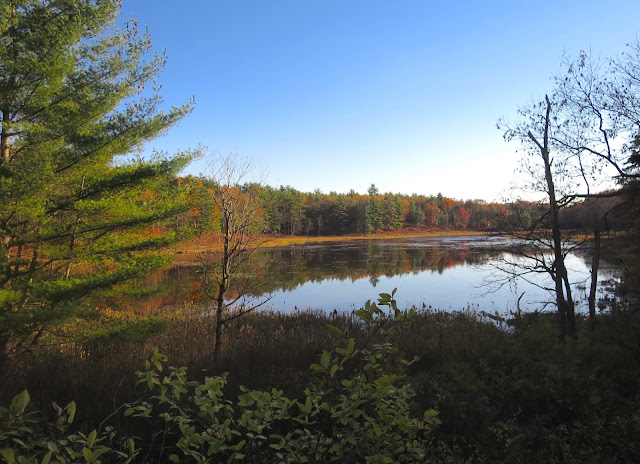Well, not exactly
fresh woods, since the woods in question have been lumbered for many years by the Finch Pruyn paper company. But I heard that these woods are now for sale, and that they may eventually be acquired by Moreau Lake State Park. If this does happen, the woods and wetlands of this tract would certainly be new to
me, as public access may be granted to this many-acred plot of land that lies between Butler/Old Bend Roads and the Hudson River. The state already owns the shore along this stretch of the river below the Sherman Island Dam in Queensbury -- note the thin green line along the river as pictured on the map below -- but the public has never been able to cross this huge plot of forested land to reach the riverbank. At this time, the land still belongs to Finch Pruyn, and since logging with its concomitant hazards continues at the site, public access remains prohibited. But I'm hoping that this situation may change sometime in the near future.

Excited to learn this news, I hurried over to Butler Road this week, hoping to maybe find a way to personally preview these lands. But after noting the prominent "No Trespassing" signs, all I could do was gaze at the site through a sturdy chain-link fence. Nevertheless, I could still enjoy imagining myself walking those logging roads through the clearings and then down to the shore of the river. Those logged-over lands offer the promise of finding the kinds of plants that populate forest clearings. And who knows what undiscovered plants I might find when I reach those yet-to-be explored riverbanks? Ooh, I just can't wait!
As I said, I couldn't wait. Convinced I could get a better sense of these lands than just a gander through the chain-links, I followed the fence for nearly a mile to where it ended at this spot on Old Bend Road. Then I followed the fence line back into the woods as far as it went, to where it ended on the banks of a flowing stream.
I remembered paddling this stream a couple of years ago, progressing against a slow current from where it entered the Hudson just upstream from the Northway bridge. I wondered at the time if this was a natural stream, or was it a canal dug out by log drivers to avoid the rapids out on the main course of the river. Because of beaver dams across this stream, I wasn't able to paddle the entire length of the waterway back then, but today I decided to see how far I could follow its banks. Could I get all the way to the river from here?
Here's one of the beaver dams that interrupted my paddle a few years back. I thought I might cross this dam today to get to the lands that abutted the Hudson, but the dam ended before it reached the far bank, leaving a gap too wide for me to leap across. And the water rushing through the gap was too deep for wading across in my ankle-high boots.
So I kept walking along the bank, and soon I came to another dam that held the stream's water back to form a pond that on this day was covered with a thin sheet of ice. At this point, an extensive wetland lay between me and where I might find access to the Hudson shore.
Nor could I proceed much further along the stream, since the banks soon grew too steep, leaving no room for a pathway along the water. So I turned back. I guess I will have to wait until the park creates trails across the lumbered lands before I can reach the river.
In the meantime, though, I enjoyed discovering the plants that grow along this stream, including many Winterberry shrubs that were thick with scarlet fruits.
When I first glimpsed these skeletal structures lying atop the leaves, I thought they might be fish bones left from an otter's dinner, but a closer look revealed that they were the bleached-out remains of Field Horsetail Reeds.
There were abundant fallen logs covered with many different kinds of mosses, liverworts, and lichens, including this thriving cluster of the Cladonia lichen called Pixie Cups. A second, narrower Cladonia, called Powderhorn, was sharing this stump.
Tufts of milkweed silk were caught on the twigs of streamside shrubs.
I drew to a halt when I came across this patch of tall plants with their tulip-shaped seed pods and caramel-colored opposite stem leaves. Gosh, but they looked familiar! What are they, I wondered, and where had I seen these before?
A closer look at the seedpods jolted my memory: these are the remains of Great St. Johnswort, a flowering plant that is listed as Rare in New York State, and one I had found only once before, on a Hudson River island upstream from where these are growing.
What a spectacular show this patch of Great St. Johnsworts will put on when the plants come into bloom next summer. Here's what they will look like then, with bright-yellow blooms over two inches across. I hope by the time they come into bloom next year, we will be able to freely roam these newly acquired woodlands and waterways. Who knows what other floral treasures we might find?
UPDATE: I did return the following summer to find this patch of Great St. Johnsworts in full bloom. Here's a link to the blog I posted about that exploration.


























































